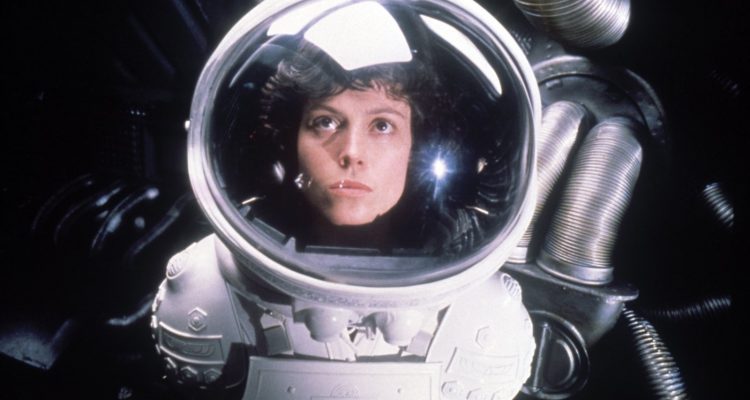 The success of “Star Wars” changed everything. While “2001” had been a giant hit a decade ago, most put it down to a fluke, but George Lucas‘ film suddenly proved that science fiction wasn’t just for B-movies, but could be a licence to print money. Every studio in town were chasing the genre, but 20th Century Fox, who had distributed “Star Wars” had a head-start: they already had another space-set script in development, “Alien,” by Dan O’Bannon, Ronald Shusett, Walter Hill and David Giler. They swiftly attached new helmer Ridley Scott to the project, and production got underway in the summer of 1978.
The success of “Star Wars” changed everything. While “2001” had been a giant hit a decade ago, most put it down to a fluke, but George Lucas‘ film suddenly proved that science fiction wasn’t just for B-movies, but could be a licence to print money. Every studio in town were chasing the genre, but 20th Century Fox, who had distributed “Star Wars” had a head-start: they already had another space-set script in development, “Alien,” by Dan O’Bannon, Ronald Shusett, Walter Hill and David Giler. They swiftly attached new helmer Ridley Scott to the project, and production got underway in the summer of 1978.
The result, released exactly two years after “Star Wars,” on May 25th, 1979 (thirty-three years ago to the day) was an enduring classic, which serves as a high watermark of the both the sci-fi and horror genres, and launched Scott’s career. Next week, the director will return to where it all started: the first screenings of “Prometheus,” his semi prequel to the original, will take place, with the film hitting theaters around the world on June 1st, before following in the U.S. on June 8th. To mark the anniversary, and the imminent arrival of “Prometheus,” we’ve gathered up five things you might not know about Scott’s sci-fi classic. Check them out below.
 1. The film came into being thanks to a beach ball.
1. The film came into being thanks to a beach ball.
Screenwriter Dan O’Bannon (who passed away in December 2009) had started out in special effects, co-writing John Carpenter‘s existential sci-fi comedy debut “Dark Star.” In that film, the alien creature (a mascot adopted by the ship’s crew, rather than an antagonist) was a spray-painted beach ball, but O’Bannon wanted to come up with something revolving around a realistic, terrifying extraterrestrial creature. Not long after, he was contacted by writer Ronald Shusett, who wanted to work together on an adaptation of Philip K Dick‘s “We Can Remember It For You Wholesale” (which would eventually become “Total Recall“), but the pair agreed to work on O’Bannon’s idea first, starting off from an uncompleted script called “Memory,” which began with astronauts awakening from a long journey. After a small delay when O’Bannon was hired for the effects on Alejandro Jodorowsky‘s aborted version of “Dune,” the two bashed out a script, initially called “Star Beast,” but soon retitled “Alien.” It was minimalist stuff — they deliberately wrote generic, interchangeable human characters, focusing more of their time on the creature — but it proved effective. The duo were on the verge of selling the film to Roger Corman‘s company when Walter Hill‘s shingle Brandywine, who had a deal at 20th Century Fox, expressed an interest. Hill, and partner David Giler, would do substantial rewrites on the film, but it was only after “Star Wars” proved to be a mammoth success that the film got the greenlight from the studio: despite Fox having released Lucas’ film, “Alien” was the only science-fiction script that the company had in the works.
 2. Robert Aldrich, Peter Yates and Jack Clayton were all in the running to direct before Ridley Scott.
2. Robert Aldrich, Peter Yates and Jack Clayton were all in the running to direct before Ridley Scott.
Initially, the studio wanted the film in the hands of a reliable veteran, and people like Peter Yates (“Bullitt,” “The Deep,” “The Friends Of Eddie Coyle“), Jack Clayton (“Room at the Top,” “The Innocents“) and Robert Aldrich (“Kiss Me Deadly,” “Whatever Happened To Baby Jane,” “The Dirty Dozen“) were all considered. Aldrich in particular nearly got the gig, but when Hill and Giler met with him, it was clear that the veteran helmer was treating it as a job-for-hire: when they asked him what he thought the facehugger should look like, Aldrich responded “We’ll put some entrails on the guy’s face. It’s not as if anyone’s going to remember that critter once they’ve left the theater.” Hill considered directing the film himself, but ended up making “The Warriors” around the same time, while O’Bannon pushed heavily for the job himself. But in the end, the studios and producers were impressed by “The Duellists,” the debut of a young British commercials director named Ridley Scott. Scott was trying to make another historical epic, “Tristan & Isolde,” at Paramount, but couldn’t get a greenlight, and jumped at the chance when it came along. From the first meeting, it was clear that Scott was the man they needed — he had no intention of treating it as a knock-off B-movie, as Aldrich had been. Indeed Fox executives were so impressed by Scott’s presentation of storyboards and designs that they doubled the budget of the film, from $4 million to over $8 million.

